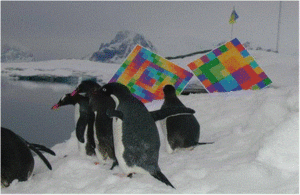
What does the Antarctic Research team comprise of?
At the Ukrainian ‘Akademik Vernadsky’ station, there are mostly medical doctors, psychologists, experts in psychophysiology and scientists in various other disciplines.
What does this research team hope to investigate?
At the moment, the team work on various areas such as hydro-meteorological climatic studies, geoinformation technologies and medical research amongst many others. Since the establishment of a Ukrainian station in the Antarctic, research has been guided towards the monitoring of health in visiting researchers and medical requirements during expeditions. In addition to previously mentioned scientific activity, NASC (National Antarctic Scientific Centre of Ukraine) continue work to educate the public about the earth’s atmosphere in polar regions and conservation of the planet’s natural resources.
Who may be predisposed to adverse health effects?
Individuals with a reduced ability to adapt to their surroundings. The primary aim of this study was to attain new information that tells us about human adaptation in extreme conditions such as those in Antarctica.
Are there ways in which people can prevent these risks?
Multi-level diagnostics are needed in order to achieve this. Predictive medicine is an integral part of PPM (Predictive, Preventive and Personalized medicine) in which research activities are focused on the prediction of human pathologies, well-timed prevention of disease and development of individualized therapies.
What extreme conditions are found in Antarctica?
The landscape is characterized by its monochrome appearance, sterility and visual monotony. In addition to this, there is also social deprivation, a limited ambient gamma environment and changes in the electromagnetic spectrum. This location has not experienced the harmful factors that are associated with anthropogenic occupation and is therefore perfect to study. These factors have permitted the understanding of changes in body function and therefore the chance to develop new technology that increases the adaptive capacity of the body.
At the Antarctic station, it is possible to monitor health under the influence of environmental factors in a relatively undisturbed form without interference. Medical observational results in Antarctica have long been used in predictive calculations for long-term space flights. It is known that long term social and sexual deprivation affect an individual’s psycho-physiological status and can alter normal biological rhythm. Since there is an impact on general body function, there is a predisposition to hypoxic conditions and psycho-emotional disorders.
How can you predict health changes under extreme conditions?
It’s important to organize educational programmes that create a screening network with unified procedures. This is so that specialists such as radiologists can evaluate participants prior to the expedition and predict unfavorable outcomes at the station. It’s also important to compare disease outcome with follow-up examinations taking place Ukraine afterwards. Constant medical supervision is required as is the need for new technology to monitor these individuals. An effective system was successfully established permitting the effective monitoring of all visitors at the station.
Why is it important to study these changes?
In order to study mechanisms of development, special conditions are required that would be impossible to create in an environment of modern civilization. Long-term medical surveillance at this station allows the identification of traditional ‘wintering diseases’ and therefore the chance to develop therapeutic and preventive measures to amend the current existing medical support system in place.
What targeted preventive measures are being applied?
The polychrome-adaptive method is one effective approach used for medical and preventive purposes. The technology is a non-invasive correction of the psycho-physiological status based on the impact of dynamic color tables by individual sensory perception. Dynamics of the color composition are based on the harmonization of color triads and executed in a table.
What potential treatments can be tailored to an individual and is this easy to do?
It’s necessary to gather large volumes of personal profile data such as genetic/molecular profiles and then alter these with respect to the individual’s response to stress and the environment; this way, a personalized approach is ensured. It’s also important to incorporate bio-regulation methods using biofeedback principles as well as optimizing central regulatory mechanisms in order to correct the negative effects of chronic and acute stress. This isn’t a simple task since many pathologies such as migraine, depression and chronic stress are not fully understood.
Where is the ‘Akademik Vernadsky’ station located?
Its geographical location is located on the island of Galindez near the Argentine Islands of the Antarctic Peninsula. Time zones were shifted 6 hours to the west of Ukraine and seasons were reversed. Global helio-geophysical and meteorological processes in the region during August, September and October lead to a reduction in the thickness of the ozone layer (the “ozone hole”). Ozone layer thickness is reduced to 150 Dobson units which contrasts with the standard 325 units in found in Ukraine.
This phenomenon led to a significant increase in solar radiation of ultraviolet. Nearby coastal Antarctica, where the station is located, there is increased activity in weather and helio-geophysical phenomena; weather conditions can change dramatically even within a day. The cyclonic activity exceeds the number observed in Ukraine is much more powerful than those registered at home.
What opportunities are there for medical research?
Antarctica is a unique place to study the health conditions of organisms in pure form under the influence of environmental factors. This region permits the study of conditions such as ‘Antarctic syndrome’ amongst many others. In addition to disease, diet and mammalian gut microbiome data are also analyzed since certain metabolites, produced by gut bacteria, are involved in controlling circadian rhythm. Since the region is essentially sterile, this permits unbiased research of the microbiome that may not be possible elsewhere.
Comments